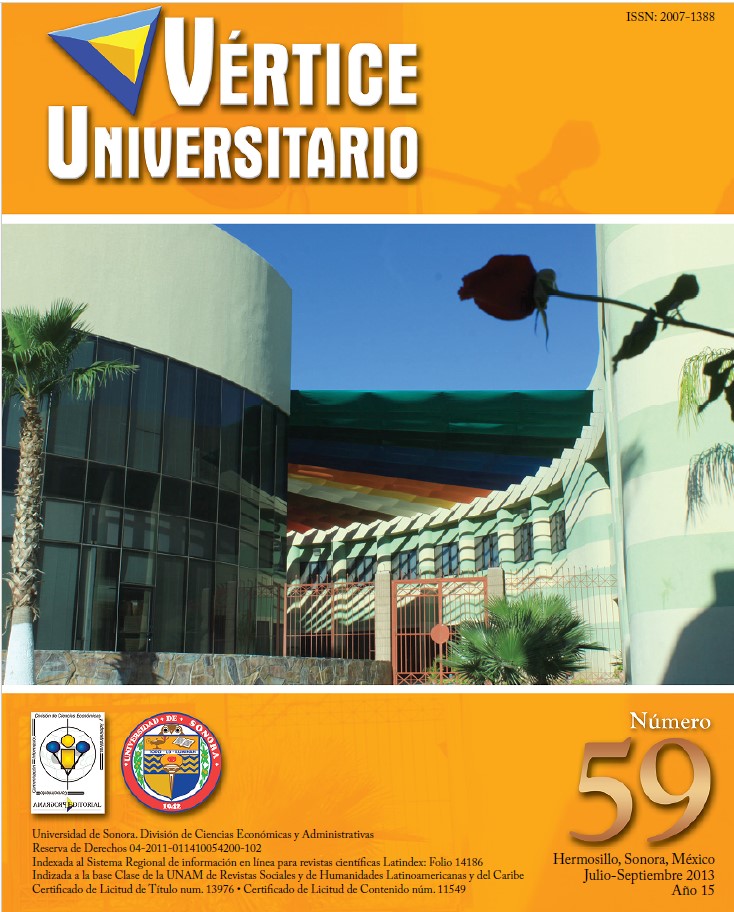The bias in the contingent valuation (local experience)
Keywords:
Contingent valuation, assets, biases, beliefs, surveys, preferencesAbstract
Techniques have been developed to try to establish the value of assets that have no market. By now it has become popular contingent valuation, one of the strongest criticisms of this technique is the multitude of biases that occur in the polls. In a project
in Mexico was possible to identify other biases that are apparently very typical of our way of being and understanding things. Beliefs, fears and prejudices cover a reality that can hardly be deciphered.
Downloads
References
Referencias:
Allport, G. W. 1985. «The Historical Background of Social Psychology.» En Handbook of Social Psychology, Volume 1: Theory and Method.
Lindsey Gardner and Elliot Aronson eds. New York: Random House, pp. 1-46.
Aristóteles (2002) Ética y ciudadanía. Andalucía. Fundación de Cultura Andaluza
Arrow. “Principle of Rationality in Collective Decisions”, 1952, Economie Appliquee “Admissable Points of Convex Sets”, con E.W. Barankwin and D.W. Blackwell, 1953, Contributions to the Theory of Games
Bishop, Richard y Heberlein, Thomas (1979). Measuring values of extra market goods: are indirect measure biased? En: American Journal
of Agricultural Economics, Vol. 65, No. 5, p. 926-930. [ Links ]
Bishop, R. C. and Heberlein, T. A. 1979. «Measuring Values of Extramarket Goods: Are Indirect Measure Biased?» American Journal of
Agricultural Economics (December). Nº 61, pp. 926-30.
Bronowski (1973). El ascenso del hombre. Bogotá. Fondo Educativo Interamericano.
Brookshire, D. S. and Schulze, W. D., eds. 1986. Valuing Environmental Goods: An Assessment of the Contingent Valuation Method. Totowa,
N.J. Bryant, J. W. 1980. «Fow Models for Assessing Human Activites.» European Journal of Operational Research (June). Nº 4, pp. 73-83.
E. Fromm ( 2007). Del tener al ser. Madrid. Paidós
KAHNEMAN, D. 1986. «Comments.» In Valuing Environmental Goods: An Assessment of the Contingent Valuation Method. Cummings,
Brookshire and Schulze eds. Totowa, N. J.
Kahneman (2005). Thinking fast and slow. Baltimore. Penguin Books
Kant (1995). Crítica De La Razón Práctica Madrid. Mestas Ediciones.
Kant (1985). La paz perpetua. Madrid. tecnos
Hanemann, Michael (1984). Welfare evaluations in contingent valuation experiments with discrete responses. American Journal of Agricultural
Economics, No 66, p. 332-341. [ Links ]
Marini (1991). Dialéctica de la dependencia. México. Era.
Paz, Octavio (1961). El laberinto de la soledad. México . Fondo de Cultura Económica
Paz, Octavio (1969). Postdata. México . Fondo de Cultura Económica.
Popper(2006). Realismo y el objetivo de la ciencia - realismo y el objetivo de la ciencia. Madrid. Tecnos
Ricardo, David (1995). Principios de economía política y tributación. Zaragoza. Pirámide
Sartre[1945]. Los caminos de la libertad. Madrid. Alianza
Schumacher (1973). Small is beautiful. Nueva York. Akal
Smith (2009). Una investigación sobre la naturaleza y causas de la riqueza de las naciones. Madrid. Tecnos
Smith (2002). La mano invisible. Madrid.Taurus Van Doren (2009). Breve Historia del Saber. Madrid. Planeta
Walras (1987). Elementos de economía política pura. Madrid. Alianza Editorial
Published
How to Cite
Issue
Section
License
Copyright (c) 2024

This work is licensed under a Creative Commons Attribution-ShareAlike 4.0 International License.
The opinions expressed by the authors do not strictly reflect the position of the publisher of the publication. This work is under a CC Attribution-ShareAlike 4.0


















